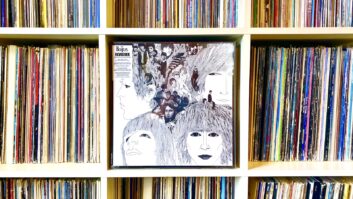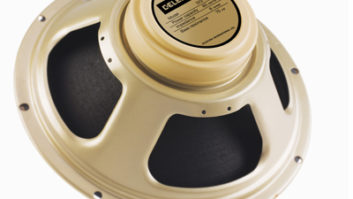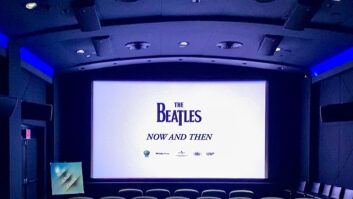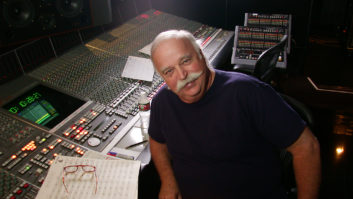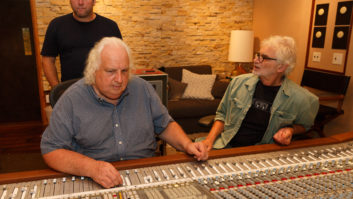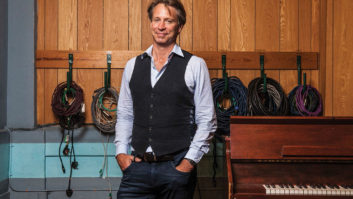What took you so long to write this book? Why now?
Over the years, a lot of people have asked me, “When are you going to write the book?” I’ve been quite shy of doing it. I still communicate with all of my friends from the past, and we find ourselves saying, “Ah, do you remember this,” and, “Do you remember that?” I just wanted to share the experience before I really forget everything. Otherwise, it’s never going to get documented.
One thing I was amazed at in the book was that your initial interest in recording came from your love of classical music.
Yeah, when I was 6, I found these old 78 rpm, 10-inch records in my grandmother’s cellar. And they fit on this toy Gramophone I had, and I just fell in love with them. I used to love “Madame Butterfly” and, uh, I think it was “Rhapsody in Blue,” George Gershwin and a few other things. It was very melodic music. Anything with melody and bit of emotion in it.
I wasn’t so much interested in the recording of them as I was just attracted by the melodies in general. I just wanted to be involved with putting music onto records.
How did you get your first interview with EMI? You were only 15 at the time.
I had been sending letters to the four major record companies—Decca, Pye, EMI and, I think, Phillips—and got rejection letters. But the careers officer at school was able to get an interview at Abbey Road.
Besides the fact of Mr. Beckett, the fellow who allocated all the sessions, nodding off during the interview, which was a bit comical, I remember being asked to draw the side elevation of a pulley wheel, which, if you think about it, was an odd thing to ask someone. It took me years to figure out why a pulley wheel; the reason being that they used to use pulleys to drive the turntables for the waxes. These guys were from that generation.
The first sessions you worked on were classical sessions, not pop records, right?
We were doing both. Some of the young guys liked the classical music sessions and some didn’t. But being the new guy, I’d be allocated to the classical stuff, which I didn’t like too much because the personnel tended to be sort of stuffed shirts. But the emotion that used to come from those performances that I heard as a young kid, it was great to see an opera being recorded live to straight stereo.
Remarkably, you started at Abbey Road just as The Beatles were making their very first record in September of ’62, and you visited that session. What do you remember about them?
It was about two days after I’d started and just to try and increase my awareness of what was going on in the studios. I wasn’t part of the session; I just snuck in at the back and watched what was going on.
On that night, I believe they were doing “How Do You Do It,” the Gerry & The Pacemakers song, which George was first trying to get them to do, instead of “Love Me Do.” I wasn’t terribly impressed; they were just young kids. I always vividly remember the slim ties they were wearing.
What was the atmosphere like in the studio when people knew there was going to be a Beatles session?
There was a buzz, for sure. And I remember, of course, that day they came to record “She Loves You.” They were first doing a photo shoot at the back of the studio. All the fans knew they were there, and I think they were waving to the fans. They’d rarely venture outside.
So the fans got more and more excited, and when we started to record, the fans burst through the gates and into the studios. I mean, they were everywhere! It was just hilarious and The Beatles were loving it.
And, of course, when we started to record, the energy from what had happened was reflected into the recording of the song. It just shows you how much, from an atmospheric point of view, that sort of stuff plays a part in recording. There’s so much energy in that song.
The book details the climb of the typical engineer up the EMI ladder at Abbey Road. Can you talk about that?
Well, you started at Abbey Road by being the assistant engineer, just looking after the tape machines. Most sessions when I first started were stereo sessions.
Because they were classical sessions.
Right. And that meant that there was no fallback on the multitrack if you screwed up. The rule was, you’re allowed to wipe something once, and, as far as I know, I never did wipe anything. But on classical sessions, they’d back it up with a second, third or fourth machine. They’d actually run four stereo machines together, and then eventually pick which one’s sound was the best, because they’ve all got different amplifiers in them, even though they’re the same machines.
It was a horrible job because there were no electronic clocks on the tape machines. There were four lots of boxes to write up. And a lot of those classical sessions were on small tapes. You’d suddenly realize there was only three minutes of tape left on each reel, and you’ve got to make the decision to stop recording and change tape. Some of those reels didn’t have backing plates on top, and sometimes they’d fly up in the air.
What were the pop sessions like?
Those you just normally had one stereo machine, a twin-track machine or mono machine, and an echo machine for live tape echo. It was delay tape fed into the reverb chamber, something called “STEED”: Send Tape Echo Echo Delay. How it worked, God only knows. There was a box in the rack, it had a knob on it. I always turned it, and I couldn’t hear anything happening.
So anyway, you started as a button-pusher. You never started in the library or sweeping the floor, like today. The next progression after that was cutting playback lacquers, because there were no cassettes then. You used to do these rough acetates, 7-inch playback acetates of the titles of the artist that had been in the previous day. If Cliff & The Shads [Cliff Richards & The Shadows] were in the night before, you’d be cutting three titles of the session. You’d come in the morning, and there would be the requisition, “We want six playback lacquers of this and six of this, et cetera.”
Did you add any EQ or compression?
You weren’t supposed to, unless there were any bass swings. There were certain rules and regulations. It was always, “Should I compress it or not?” or, “I better not, I might get into trouble.” The next step was moving into actually being a mastering engineer,and actually cut the masters that went into the shops.
And you did that quite a while, up until 1966, right?
Right. And that meant that you were taken off the run—off the sessions. The only time you got back into the studio was for overtime sessions.
So you didn’t get much opportunity to learn about the recording process itself during that period?
I learned what I could when I was being a second engineer. [Original Beatles engineer] Norman Smith taught me a lot. The main thing he always said was, “It happens down in the studio, not in the control room.”
On what Beatles sessions did you work with Norman?
The earliest session was the piano overdub session for “Misery” on the Please Please Me album. I also did the title track for A Hard Day’s Night.
Outside of the occasional session, did you have any other interaction with any of The Beatles while you were mastering?
Paul used to wander down into my room at lunchtimes, ’cause he used to like to get out of the studio. We’d have little chats. There was no friendship outside of the studio, but he used to be someone to have a chat with.
What kinds of things did you cut when you were mastering?
I used to get a lot of American records in and was in awe of the sound, compared with what was on the records we had. The bass content was a lot heavier. A lot of it was the musicianship, but there was obviously a technical aspect, too. One of our jobs we had was when we’d master the Tamla/ Motown records. They’d have sent us the 7-inch single instead of a master tape. This was dubbed onto a tape from the turntable and then we’d remaster it. If there were any bad clicks, they were physically cut out with a pair of scissors.
Did you ever master any Beatles records?
No, Malcolm Davies was mastering then. I learned all my mastering techniques from Malcolm, who was brilliant.
What sort of things did you learn from Norman Smith?
We used to have an equalizer called a “curve bender.”It was one of those huge, primitive equalization boxes. They weren’t installed in the control rooms, but were in the mastering rooms. Malcolm used to tell me of a “secret frequency”—always 512 cycles. If you took 2 dB out of 512, your level will drop by 2 dB, and you lift the level 2 dBs and get a slightly louder record.
He used to tell me about certain mics sounding different ways. So then I realized, “Oh, yeah, that mic’s gonna sound dull, that’s gonna sound bright, et cetera.” That’s why I sort of interpreted microphones as camera lenses. That’s the easiest way I can mentally perceive microphones. I usually think of sounds visually in my head. When I’m mixing, I see shades and tones and colors.
Norman also always said that you could lift one mic up, and if the group was rehearsing, you could hear immediately, with one mic up, if you had a hit on your hands.
Your talk in the book about your promotion from mastering engineer to balance engineer [recording engineer] being a surprise.
Well, when I first started there, [they had said,] “Well, you’ll be doing this, and then you’ll spend some years up in the mastering room,” because some of those guys had been up there for years. And I remember someone saying to me one day, “You know, you’ll probably be 40 by the time you’ll be a balance engineer.” I know Norman was in his 40s. I figured it would take 20 years before I’d ever be a recording engineer.
What happened was, Norman wanted to leave to be a producer. I think he wanted to still engineer with The Beatles and also be an EMI producer. But that wouldn’t really have worked, having Norman, an EMI producer, working alongside George Martin—in theory Norman would have been a producer and engineer, and you can’t do both jobs.
There was some discussion behind the scenes about me being given the job, which, being so young, just took me by surprise. I guess I was pretty good at my job, just kept my mouth shut and did a generally good job cutting the playback lacquers and mastering. But I was young and very nervous.
What was your first hit as an engineer?
The first thing I had a hit with was Manfred Mann’s “Pretty Flamingo.” That was the first time I put the dobro guitar through the Fairchild limiter and got that—for those days—a brilliant, bright sound. It leapt out of the speakers.
NOTABLE QUOTES
The 4-track was remote; in those days, it was never in the control room. We had two 4-track rooms where the tape machines were, and there were three studios, so they had to patch them through. But because of the difficulties of recording “Tomorrow Never Knows,” with the backward things and so forth, where you had to communicate with an intercom to tell the tape op to drop in—which was ridiculous—we requested that the 4-track machines be brought into the control room. Well, that was just a “no go” area, but eventually they relented. And they sent out six technical staff from the main EMI technical department to supervise the moving of the 4-track machine up the corridor.
—October 2002
On working with Nellie McKay for her Get Away From Me album:
I was attracted to the lyrics immediately. Elvis Costello immediately came to mind. Her level of maturity at such a young age is astounding. You come across an artist of this caliber once every 10 or 15 years. And I don’t do a lot of projects these days unless something really stands out like this did. My approach with this, because it was jazz, was simply to go by feel. There was no click track; I didn’t want to bring any computers into it. You know, like ‘Tomorrow Never Knows’?
—September 2004
